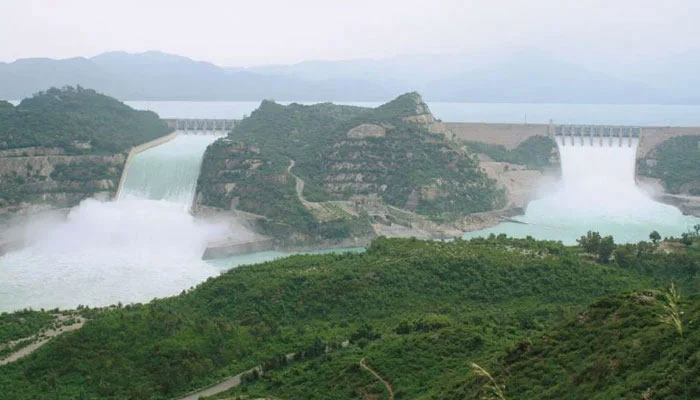Wapda asks IRSA to release water from Tarbela Dam beyond 1,420ft storage mark
In the IRSA technical committee meeting, Sindh has already shown its concerns over the Wapda’s failure to complete its tunnel projects
ISLAMABAD: In a new development, Wapda has asked IRSA to release water from the Tarbela Dam beyond the storage level of 1,420 feet mark while the initiative may jeopardize the sowing of two main Kharif crops, cotton and rice, in Sindh.
Wapda’s instructions to IRSA came in the backdrop of requirement of water for construction of tunnel project (T3) as water withdrawal from low-level outlets will hurt the construction work.
Interestingly, Sindh desperately needs water releases from Tarbela Dam at Indus during the early Kharif period from April 1 to June 10. In case cotton crop production in 2024-25 is affected, the textile sector would have to import it for billions of dollars.
In the IRSA technical committee meeting, Sindh has already shown its concerns over the Wapda’s failure to complete its tunnel projects. Sindh in the meeting stressed maximum water releases from the Tarbela reservoir from low-level outlets so that it could sow cotton and rice on time. Sindh in the meeting stated clearly that at Kotri Barrage, which is the last on Indus, there is no water available even for drinking purposes and in the Nara Canal and others, there was 70 to 80 percent water shortage.
When contacted, Sindh Irrigation Minister Jam Khan Shoro said the advisory committee meeting on April 2 would take up the issue. However, Sindh needs maximum water releases in early Kharif; otherwise, it will brave an unmatchable loss in Kharif crops’ production. “We do not support the storing of water to the level Wapda has asked for. Sindh needs maximum water releases as per the water accord and if there is a shortage, it should be passed on to all the provinces,” said the minister.
In its letter sent to IRSA on March 26, 2024, Wapda’s chief engineer at Tarbela Dam asked IRSA to first maintain the water level at 1,420 ft for releasing the water as the lowering of reservoir to the low-level outlet will halt the ongoing construction activities of the tunnel project – T3 trash racks replacement, which is scheduled to be completed by April 13, 2024, and cause an unaffordable delay in project completion. The project director of T4 earlier sent the same letter to IRSA’s technical wing.
This new letter has made IRSA indecisive on working the water deficit figures in early Kharif for Sindh as Wapda wants first to store water up to 1420 ft and maintain the level while releasing the water. If water is released to Sindh as per Wapda’s assertion, IRSA would have to release the water with shortages to Sindh that will not be acceptable to the lower riparian federating unit.
However, an IRSA official says that Wapda’s letters on its tunnel projects and its failure to complete projects T3, T4, and T5 on time will be considered for decision on the water release plan from reservoirs of Tarbela Dam and Mangla Dam with water deficit to provinces, particularly for Sindh, in the advisory committee that will meet on April 2. All members of IRSA, secretaries of irrigation and power departments of the four provinces, representatives of the Met Office and Wapda’s member water would attend the advisory committee. The sowing of the Kharif crops in Punjab starts in some pockets from mid-May depending upon the harvesting of wheat crops.
-
 Prince Harry Risks Making King Charles Choose Between Queen Camilla And Military Duty
Prince Harry Risks Making King Charles Choose Between Queen Camilla And Military Duty -
 Inside How Kate Middleton Stayed Steady Amid Cancer And Royal Chaos
Inside How Kate Middleton Stayed Steady Amid Cancer And Royal Chaos -
 Kate Hudson Jokes She May Write A Script To Star Alongside This Actress
Kate Hudson Jokes She May Write A Script To Star Alongside This Actress -
 Kanye West's Wife Bianca Censori Shows Off Hidden Talent
Kanye West's Wife Bianca Censori Shows Off Hidden Talent -
 Kate Middleton Has Learnt Her 'lesson' After 'powering Through'
Kate Middleton Has Learnt Her 'lesson' After 'powering Through' -
 Will Prince Harry Be A Working Royal Again For Archie, Lilibet’s Royal Prospects? Expert Answers
Will Prince Harry Be A Working Royal Again For Archie, Lilibet’s Royal Prospects? Expert Answers -
 Chile In Danger: Deadly Wildfires Kill 20,forced 50,000 To Flee; President Declares ‘State Of Catastrophe’
Chile In Danger: Deadly Wildfires Kill 20,forced 50,000 To Flee; President Declares ‘State Of Catastrophe’ -
 Prince Harry’s Relationship With King Charles 'changes' With Archie, Lilibet’s UK Doors Opening
Prince Harry’s Relationship With King Charles 'changes' With Archie, Lilibet’s UK Doors Opening -
 Sara Waisglass Addresses Fans Concerns About Recasting In 'Ginny & Georgia'
Sara Waisglass Addresses Fans Concerns About Recasting In 'Ginny & Georgia' -
 Tim Allen Reflects On Stepping Into Mentorship During 'Home Improvement' Gig
Tim Allen Reflects On Stepping Into Mentorship During 'Home Improvement' Gig -
 Royal Tensions Rise As King Charles Navigates Prince Harry, William Feud
Royal Tensions Rise As King Charles Navigates Prince Harry, William Feud -
 Katie Bates Husband Travis Clark Confesses He Cheated On Her
Katie Bates Husband Travis Clark Confesses He Cheated On Her -
 Andrew Makes Life As Newly Stripped Commoner Offensive To The People
Andrew Makes Life As Newly Stripped Commoner Offensive To The People -
 Kansas Woman Loses $255,000 In Gold In FBI Impersonation Scam
Kansas Woman Loses $255,000 In Gold In FBI Impersonation Scam -
 Prince Harry Arrives In UK To Fight His Phone Hacking Case
Prince Harry Arrives In UK To Fight His Phone Hacking Case -
 Nick Jonas Attempts To Take Break From Jonas Brothers With Upcoming Solo Album?
Nick Jonas Attempts To Take Break From Jonas Brothers With Upcoming Solo Album?




